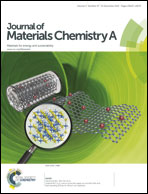Validation of green composite containing nanocrystalline Mn2O3 and biocarbon derived from human hair as a potential anode for lithium-ion batteries†
Abstract
Mn2O3 nanoparticles encapsulated with nitrogen- and sulfur-doped randomly oriented graphene sheet-like biocarbon derived from human hair (HHC) form a Mn2O3/HHC nanocomposite through a cheap, scalable and highly reproducible process. Such a Mn2O3/HHC nanocomposite anode exhibits excellent electrochemical performance, which is superior to that of the pristine Mn2O3 anode in lithium-ion batteries (LIBs). A steady state reversible capacity of 990 mA h g−1 has been obtained at 50 mA g−1, which is about 98% of the theoretical capacity and the highest ever capacity achieved so far for Mn2O3 based anode materials. The Mn2O3/HHC nanocomposite anode delivers capacity in the range of 1250 to 450 mA h g−1, when the current density is varied from 100 to 2000 mA g−1, highlighting the excellent rate capability and reversibility. The reversible specific capacity value obtained for the Mn2O3/HHC nanocomposite anode is at least three times higher than that of the commercial graphite anode. The impressive electrochemical performance of the Mn2O3/HHC nanocomposite anode results from the multiple synergistic advantages offered by HHC, such as enhancing the electrode conductivity, maintaining the structural integrity upon cycling and mitigating the inherent severe volume change. Our results indicate that the currently synthesized Mn2O3/HHC nanocomposite anode could be considered as a promising candidate for next generation hybrid energy storage applications. The present work suggests the possibility to exploit earth abundant, environment friendly and low cost Mn2O3 based composite anodes for high capacity and high rate lithium-ion battery applications.


 Please wait while we load your content...
Please wait while we load your content...